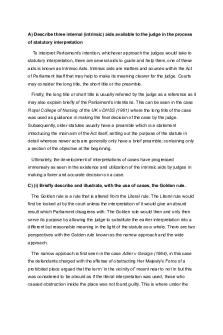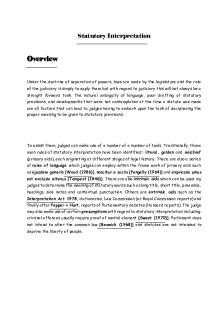Statutory Interpretation PDF

| Title | Statutory Interpretation |
|---|---|
| Author | JM REDWAN |
| Course | Legal system and method |
| Institution | University of London |
| Pages | 6 |
| File Size | 121.7 KB |
| File Type | |
| Total Downloads | 632 |
| Total Views | 721 |
Summary
Statutory InterpretationConstitutionally, statute law is the supreme form of law within the UK, subject to compatibility with European Union Law and Human Rights Act 1998. Although Parliament makes legislation, it is left to the courts to apply. Once the parliament has passed legislation, it is up t...
Description
Statutory Interpretation Constitutionally, statute law is the supreme form of law within the UK, subject to compatibility with European Union Law and Human Rights Act 1998. Although Parliament makes legislation, it is left to the courts to apply. Once the parliament has passed legislation, it is up to the judiciary to make sense of the provision in statutes to interpret the meaning of the word. The role of the judiciary in relation to the legislature is to ‘give effect’ to the Parliament’s intention. However, some statutes are poorly drafted and ambiguous, thus it presents particular problems to the judiciary. The courts do whatever they can do to make sense. However, different approaches are taken to the problem.
The Rules of Interpretation The judiciary has formulated various methods of interpretation which they use to interpret ambiguous statutory provisions. Over the centuries four different rules have been used and are discussed below.
The Literal Rule By the literal rule, words in the statute must be given their plain, ordinary or literal meaning. Under this rule the literal meaning must be followed, even if the result is impractical. Lord Esher in R V City of London Court Judge that- ‘if the words of an Act are clear, you must follow them even though they lead to a manifest absurdity’. In the literal rule, the objective of the court is to discover the intention of the Parliament as expressed in the words used. In the name of judicial independence and keeping faith to the law alone, many judges preferred a strictly literal approach. For example, in R V Harris the court held that the words of the statute indicated that for the offence to be committed some form of instrument had to be used. Therefore, the court had decided that a defendant who bit off the end of the victim’s nose had not committed the offence. Another example is the Berriman case.
The Golden Rule
This is a modification of Literal rule. The judge begins to interpret literally but if this leads to an absurdity then the judge may modify the words to some extent. This approach was explained by Lord Wensleydale in the case of Grey V Pearson that the grammatical and ordinary sense of words is to be adhere to, unless that would lead to some absurd result then on that case the ordinary meaning can be modified as to avoid the absurdity.
This provides that if the literal rule gives an absurd result, which Parliament could not have intended then the judge can substitute a reasonable meaning in the light of a statute as a whole. An example of the use of the rule is the case of Adler V George under S.3 of Official Secrets Act 1920. It was an offence to obstruct Her Majesty’s Forces ‘in the vicinity’ of a prohibited area. He argued that he was not in the vicinity of a prohibited place since he was actually in a prohibited place. The court applied the golden rule to extend the literal wording of the stature to cover the action committed by the defendant. Had the literal rule had been applied, it would have produced absurdity.
The Mischief Rule
Sometimes, statute can be used or defines more broadly by the courts to deal with unforeseen ambiguity within the legislation, which may prevent Parliament’s original intention being honored. This application is known as the Mischief Rule. And will be used where there is ambiguity. The mischief rule was laid down in the landmark Heydon’s Case in 1584 where the court said that – Four issues need to be considered when interpreting statutes. These were to examine the common law prior to the act, locate the mischief
of defect in the common law, identify the remedy Parliament meant to propose to eliminate the mischief and finally give effect to that remedy. The mischief rule is narrower than the golden rule and only applied to determine the mischief and defect that the statute was intended to remedy. A Classic example of the mischief rule which was applied in the case of Smith V Huges (1960). This case involved interpretation of S.1 of Street Offences Act
1959. The provision provided: The accused was in the house tapping on the window to attract the attention of the passer-by. She argued that she was not ‘in the street’. Instead of adopting a literal approach, the court considered what ‘mischief’ the act was aimed at. Lord Parker CJ found that a secondary meaning of the words. It was a ‘solicitation’ which must take in the street, not the person who does soliciting.
Purposive Approach
Although similar to the mischief rule, judges adopting a purposive approach to interpretation are taking a wider view and essentially trying to decide what Parliament intended to achieve in passing an Act. This approach encourages the judge to look for the ‘spirit of the Act’ and to read words into or out of the Act when this is necessary.
In recent years the judiciary appear to be more comfortable using a purposive approach to interpretation. To some extent this may reflect the effect of dealing with European legislation. In the case of Pepper V Hart the House of Lords accepted that the courts are now ready to adopt an approach that seeks to give effect to the ‘true purpose’ of legislation. Another important case in which the court adopted a purposive interpretation was R (on the application of Quintavalle) V Secretary of State for Health (2003) concerning research on human embryos. Thus the purposive approach to statutory interpretation seeks to look for the purpose of the legislation before interpreting the words. It is often said that Purposive Approach is a mixture of the domestic law. However, whereas the domestic rules require the courts to apply the literal rule first to look at the wordings of the Act, the purposive approach starts with the mischief rule in seeking the purpose or intention of the Parliament. It is thought that today, there are only two approaches to interpretation: The Literal Rule and the Purposive Approach. It is favored method as per the Law Commission.
Advantages of Purposive Approach *It is a flexible approach which allows judges to develop the law line with Parliament’s Intention. Maunsell V Olins *It allows judges to cope with situations unforeseen by Parliament. Quintavalle *It allows the law to develop to cover advances in Medical Science. *It allows the court to give effect to EU directives. Pickstone V Farmers *Allowing reference to Hansard makes it easier for the courts to discover Parliament’s intention.
Disadvantages of Purposive Approach *Judges are given too much power to develop the law and usurping the power of Parliament. *Judges become law makers infringing the separation of Powers. Montesquieu *There is scope for judicial bias in deciding what Parliament intended. *It assumes that Parliament had one intention and ignores the fact that Parliament is divided on party lines.
Giving effect to Parliament’s intention
Whatever approach judges take to Statutory Interpretation they are always seeking to give effect to Parliament’s intention. That is their constitutional role and judges take that responsibility seriously. However, as this discussion has shown, different judges approach the task in various ways. Some may think that the best way to give effect the Parliament’s intention is to stay close to the words that Parliament actually used via a literal approach to interpretation. Other judges might feel that they are better be able to give effect to Parliament’s intention by seeking to understand the purpose of the legislation and then reading words in or out in order to achieve that aim.
Interpreting the law of the European Union S.2 (4) of the European Communities Act 1972 provides that English law should be interpreted and have effect subject to the principle that European Law is supreme. Where an English statute cannot be interpreted in a way that is consistent with EU law, the inconsistent law should not be applied R V Secretary of State for Transport exp Factortame No.2. The CJEU has shown that in its approach to legislative interpretation, it is more likely to be influenced by the context and purposes of a legislative provision that its precise wording. In the case of Van Gend en Loos. In interpreting EU legislation, the English courts have to take somewhat different approach to the traditional approach used in domestic legislation.
Fennelly stated that- while all judges are seeking to give effect to legislation, judges from different legal traditions vary in their approach. The object of all interpretation lies in the true intention of the lawmakers, whether they be framers of a constitution or a treaty, legislators, or drafters of secondary legislation. Lord Denning in the case of H P Bulmer Ltd V J Bollinger SA stated that “when English courts are faced with a problem of interpretation they must follow the European pattern and look for the purpose or intent rather than examining the words in meticulous detail. They must deduce from the wording and the spirit of the Treaty the meaning of Community rules. If the find a gap they must fill it as best they can. In a case of few years later, Lord Denning provided further explanation of the difference between English and European approaches to interpretation. In Bechanan and Co Ltd V Babco Forwarding and Shipping (UK) Ltd Lord Denning argued that it was necessary to move away from traditional rules of interpretation that stress the literal meaning of words and adopt the European method. He said that European judges solve the problem by looking at the design and purpose of the legislature at the effect which it sought to achieve. They then interpret the legislation so as to produce the desired effect. Lord Denning said that there is nothing wrong in this. It is clear that the more modern ‘purposive’ approach
adopted by English courts has much in common with the European approach. Moreover, it has been argued that the influence of the EU has begun to affect the way that judges interpret domestic legislation
The Impact of HRA 1998 on Statutory Interpretation When the Government introduced the HRA 1998 it intended that both Acts of Parliament and Secondary legislation should be interpreted, so far as possible, to be compatible with the Convention. Previously, the English courts were merely required to take the Convention into account in resolving any ambiguity in a legislative provision. Under the HRA 1998 the English courts must interpret legislation so as to uphold the Convention rights unless the legislation itself is clearly incompatible with the Convention that it is impossible to do so. This ‘rule of construction’ applies to past as well as to future legislation. To the extent that it affects the meaning of a legislative provision. The courts are not bound by previous interpretations. This approach to interpretation is contained within S.3 (1) of the HRA 1998 which provides that so far as it is possible to do so, primary legislation and subordinate legislation must be read and given effect in a way which is compatible with the Convention rights.
Section 4(2) of the HRA 1998 provides that if the court is satisfied that the provision is incompatible with the Convention right, it may make a declaration of that incompatibility. Declaration of incompatibility are intended to be used as a last resort. Declarations of incompatibility have no effect on the validity or continuing operation of the legislation. But under S.10 of the Act, a declaration of incompatibility may lead to the provision being amended or repealed by Parliament.
The first declaration of incompatibility was issued in R V (1) Mental Health
Review Tribunal, North & East London Region (2) Secretary of State for Health ex p H in March 2001. In the case of Bellinger V Bellinger a postoperative male to female transsexual appealed against a decision that she was not validly married to her husband, by virtue of the face that at law she was a man. Section 11(C) of the Matrimonial Causes Act 1973 was declared incompatible with Articles 8 and 12 in so far as it made no provision for the recognition of gender reassignment Goodwin V UK the ECtHR had already identified the absence of any system for legal recognition of gender change as a breach of Articles 8 and 12. This was remedied by the Gender Recognition Act 2004, which came into force on 4 April 2005.
In conclusion it may say that the interpreting obligation goes far beyond the present rule which enables the courts to take the Convention into account in resolving any ambiguity in a legislative provision. The courts will be required to interpret legislation so as to uphold the convention rights unless the legislation itself incompatible with convention that it is impossible to do so. This indicated that the courts would be obliged to give human rights-compatible meaning bot where the legislation is ambiguous and where it is clear.
____________________________________________________________________________________...
Similar Free PDFs

Statutory Interpretation
- 6 Pages

Statutory Interpretation
- 6 Pages

Statutory Interpretation
- 3 Pages

Statutory Interpretation
- 5 Pages

Statutory Interpretation
- 11 Pages

Statutory Interpretation
- 6 Pages

Statutory interpretation notes
- 2 Pages

Statutory Interpretation 70102
- 5 Pages

Statutory Interpretation in Malaysia
- 12 Pages

Statutory Interpretation Notes
- 9 Pages

Statutory Interpretation Notes
- 4 Pages
Popular Institutions
- Tinajero National High School - Annex
- Politeknik Caltex Riau
- Yokohama City University
- SGT University
- University of Al-Qadisiyah
- Divine Word College of Vigan
- Techniek College Rotterdam
- Universidade de Santiago
- Universiti Teknologi MARA Cawangan Johor Kampus Pasir Gudang
- Poltekkes Kemenkes Yogyakarta
- Baguio City National High School
- Colegio san marcos
- preparatoria uno
- Centro de Bachillerato Tecnológico Industrial y de Servicios No. 107
- Dalian Maritime University
- Quang Trung Secondary School
- Colegio Tecnológico en Informática
- Corporación Regional de Educación Superior
- Grupo CEDVA
- Dar Al Uloom University
- Centro de Estudios Preuniversitarios de la Universidad Nacional de Ingeniería
- 上智大学
- Aakash International School, Nuna Majara
- San Felipe Neri Catholic School
- Kang Chiao International School - New Taipei City
- Misamis Occidental National High School
- Institución Educativa Escuela Normal Juan Ladrilleros
- Kolehiyo ng Pantukan
- Batanes State College
- Instituto Continental
- Sekolah Menengah Kejuruan Kesehatan Kaltara (Tarakan)
- Colegio de La Inmaculada Concepcion - Cebu




